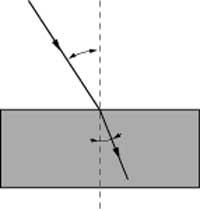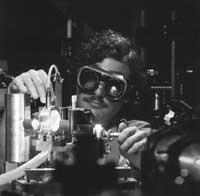Refraction
Refraction itself is only a consequence of the speed of light. As we all know, although the speed of light is extremely high, it is not infinite, that is, the rays of light need a deadline to meet a distance. This speed is so high (300,000 km/s in vacuum) that in most cases it is not taken into account and considered infinite.

But that speed is there and in each environment it has a special value, always very high, yes. In the vacuum it has what was said above and is the largest of possible.
Who hasn't seen or used a pair of glasses? Or a magnifying glass?. The lenses used in these devices and in many other optical devices only use refraction. Therefore, it is necessary to know and understand the reason for refraction.
Why the refraction of light
The rays of light, passing from one medium to another, due to the speeds they have in each of them, modify their direction. This phenomenon is known as refraction. For many this is only a curiosity of Nature: when they travel in one medium, if the rays have one direction, when they pass to another, why do they incline that direction? Light does what all other moving waves do. To demonstrate this, the astronomer and physicist of the last century, John Herschel, gave us a clear example: the one that occurs when a military group passes from one plot to another more difficult to travel. Let's see how he said:
“Let us think that a military group in formation moves through a terrain and that a straight line divides the ground into two zones: one smooth, clean and accessible, and another smooth, deaf and that it does not allow to walk as fast as the other.

Let us also think that the front of the group forms an angle with the line of separation between the two zones, so not all the soldiers who form that front reach the same line, but one after the other. In this situation, once the limit is exceeded, you cannot go as fast as before. With the rest of the soldiers in his line, that is, with those in better ground, he will not form the line and will be delayed more and more.
The same thing will happen to each soldier who overcomes the border, since he finds the same obstacle to walk, and if the formation does not break, the part that has passed the border will be delayed compared to the other, forming an obtuse angle to it at the point of transition of the border line. And as you have to keep the step without hindering each other, each soldier must move forward forming a right angle to the new front of the column. Therefore, once the line is overcome, the path that each of them leads will be, on the one hand, associated with the new front and, on the other, the relationship between the path traveled and the one that would work in case it had not been a delay is equal to the new and the previous speed.”
That is what happens to the light. We can perform a simple test on our table to have a graphic representation of the refraction of light. To do this, half of the table is scaled with a zamau and, after a slight bending, two wheels are placed on it with the same axis, ie any broken toy. If the direction of the wheels is attached to the edge of the zamauque, the road does not tilt. In this case, it is the expression of the law “the ray of light associated with the distribution plane is not refracted” that occurs in optics.

On the contrary, if the direction of the movement of the wheels forms an angle with the edge of the load, the path they carry is twisted when arriving at that edge, that is, there is the difference between the speeds of the wheels at the limit of both zones. When moving from the top speed part (i.e. no load) to the lower speed part (i.e., with loading to shelf), the direction of the track (of lightning) approaches the “associated incidence” and vice versa when moving from load to clean table.
From all this we can draw a conclusion of great importance that indicates the essence of the phenomenon that concerns us, that is, that refraction is conditioned by the difference between the speeds of light in both media. And the refraction will be greater the greater the difference. Therefore, the so-called refractive index, which is used to express the deviation of rays, is only the relationship between these speeds.
Therefore, when moving from the air to the water they tell us that the refractive index is 4/3, for example, the light goes 1.3 times lighter than the air.
Buletina
Bidali zure helbide elektronikoa eta jaso asteroko buletina zure sarrera-ontzian











